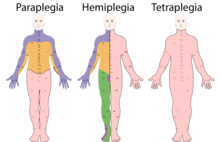
Back شلل الأطراف الأربعة Arabic Tetraplexa AST Tetraplegia Catalan Kvadruplegie Czech Tetraplegie German Tetraplegìa EML Tetraplejía Spanish Tetrapleegia Estonian Tetraplegia Basque فلج چهاراندام Persian
| Tetraplegia | |
|---|---|
| Other names | Quadriplegia |
 | |
| Affected areas (pink) representing differences between paraplegia (left), hemiplegia (middle), and tetraplegia (right). Areas may differ for each condition and are dependent upon level of injury. | |
| Specialty | Neurosurgery, physical medicine & rehabilitation |
| Types | Complete, incomplete |
| Causes | Damage to spinal cord or brain by illness or injury; congenital conditions |
| Diagnostic method | Based on symptoms, medical imaging |
Tetraplegia, also known as quadriplegia, is defined as the dysfunction or loss of motor and/or sensory function in the cervical area of the spinal cord.[1] A loss of motor function can present as either weakness or paralysis leading to partial or total loss of function in the arms, legs, trunk, and pelvis. (Paraplegia is similar but affects the thoracic, lumbar, and sacral segments of the spinal cord and arm function is retained.[1]) The paralysis may be flaccid or spastic.[2] A loss of sensory function can present as an impairment or complete inability to sense light touch, pressure, heat, pinprick/pain, and proprioception.[1] In these types of spinal cord injury, it is common to have a loss of both sensation and motor control.